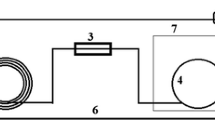Abstract
Salvia divinorum is a hallucinogenic herb that is internationally regulated. In this study, salvinorin A, the active compound in S. divinorum, was extracted from S. divinorum plant leaves using a 5-min extraction with dichloromethane. Four additional Salvia species (Salvia officinalis, Salvia guaranitica, Salvia splendens, and Salvia nemorosa) were extracted using this procedure, and all extracts were analyzed by gas chromatography–mass spectrometry. Differentiation of S. divinorum from other Salvia species was successful based on visual assessment of the resulting chromatograms. To provide a more objective comparison, the total ion chromatograms (TICs) were subjected to principal components analysis (PCA). Prior to PCA, the TICs were subjected to a series of data pretreatment procedures to minimize non-chemical sources of variance in the data set. Successful discrimination of S. divinorum from the other four Salvia species was possible based on visual assessment of the PCA scores plot. To provide a numerical assessment of the discrimination, a series of statistical procedures such as Euclidean distance measurement, hierarchical cluster analysis, Student’s t tests, Wilcoxon rank-sum tests, and Pearson product moment correlation were also applied to the PCA scores. The statistical procedures were then compared to determine the advantages and disadvantages for forensic applications.






Similar content being viewed by others
References
Epling C, Játiva C (1962) A new species of Salvia from Mexico. Bot Mus Leafl 20
Siebert D (2004) Localization of salvinorin A and related compounds in glandular trichomes of the psychoactive sage, Salvia divinorum. Ann Bot Lond 93:763–771
US Department of Justice (2010) D.E.A. Drugs and Chemicals of Concern: Salvia divinorum and salvinorin A. Office of Diversion Control, US Drug Enforcement Administration (DEA), Arlington
House Bill 6038, Ninety-fifth Legislature State of Michigan, October 2010
Salvia divinorum and salvinorin A. U.S. Department of Justice, Drug Enforcement Administration. 02/17/10. Available at www.justice.gov/dea/concern/Salvia%20divinorum%20and%20salvinorin%20A_Feb%202010%20wo%20image.pdf. Accessed September 2011
Munro T (2006) The chemistry of Salvia divinorum. Dissertation, University of Melbourne, Melbourne, Australia
National Research Council of the National Academies (2009) Strengthening forensic science in the United States: a path forward. The National Academies Press, Washington
Esseiva P, Anglada F, Dujourdy L, Taroni F, Margot P, Pasquier E, Dawson M, Roux C, Doble P (2005) Chemical profiling and classification of illicit heroin by principal component analysis, calculation of inter-sample correlation and artificial neural networks. Talanta 67:360–367
Klemenc S (2001) In common batch searching of illicit heroin samples—evaluation of data by chemometric methods. Forensic Sci Int 115:43–52
Brereton R (2007) Applied chemometrics for students. Wiley, West Sussex, England
Hupp A, Marshall L, Campbell D, Smith R, McGuffin V (2008) Chemometric analysis of diesel fuel for forensic and environmental applications. Anal Chim Acta 606:159–171
Devore J (1990) Probability and statistics for engineering and the sciences. Duxbury Press, Belmont, CA
Johnson K, Wright B, Jarman K, Synovec R (2003) High-speed peak matching algorithm for retention time alignment of gas chromatographic data for chemometric analysis. J Chromatogr A 996:141–155
Willard M (2011) Forensic analysis of Salvia divinorum and related Salvia species using multivariate statistical procedures. Dissertation, Michigan State University, East Lansing, MI, USA
Gruber J, Siebert D, Der Marderosian A, Hock R (1999) High performance liquid chromatographic quantification of salvinorin A from tissues of Salvia divinorum Epling & Jativa-M. Phytochem Anal 10:22–25
Jermain J, Evans H (2009) Analyzing Salvia divinorum and its active ingredient salvinorin A utilizing thin layer chromatography and gas chromatography/mass spectrometry. J Forensic Sci 54:1–5
Tsujikawa K, Kuwayama K, Miyaguchi H, Kanamori T, Iwata Y, Yoshida T, Inoue H (2008) Determination of salvinorin A and salvinorin B in Salvia divinorum-related products circulated in Japan. Forensic Sci Int 180:105–109
Leger C, Lira H, Paterson R (1996) Preparation and properties of surface modified ceramic membranes. Part II. Gas and liquid permeabilities of 5 nm alumina membranes modified by a monolayer of bound polydimethylsiloxane (PDMS) silicone oil. J Membr Sci 120:135–146
Walker J, Sytsma K, Treutlein J, Wink M (2004) Salvia (Lamiaceae) is not monophyletic: implications for the systematics, radiation, and ecological specializations of Salvia and tribe Mentheae. Am J Bot 91:1115–1125
Barton A (1975) Solubility parameters. Chem Rev 75:731
Acknowledgments
The authors acknowledge Dr. Joseph Tychonievich and Prof. Ryan Warner (Department of Horticulture, Michigan State University) for samples of S. guaranitica, S. splendens, and S. nemorosa. Dr. Kathryn Severin (Department of Chemistry, Michigan State University) is also acknowledged for training and use of the GC-MS. This project was partially funded by the Midwest Forensics Resource Center (grant no. SC-10-335) and by a Forensic Sciences Foundation/National Institute of Justice Student Research Grant. The opinions, findings and conclusions or recommendations expressed in this publication are those of the author(s) and do not necessarily reflect those of the Department of Justice.
Author information
Authors and Affiliations
Corresponding authors
Electronic supplementary material
Below is the link to the electronic supplementary material.
ESM 1
(PDF 339 kb)
Rights and permissions
About this article
Cite this article
Bodnar Willard, M.A., McGuffin, V.L. & Waddell Smith, R. Forensic analysis of Salvia divinorum using multivariate statistical procedures. Part I: discrimination from related Salvia species. Anal Bioanal Chem 402, 833–842 (2012). https://doi.org/10.1007/s00216-011-5479-0
Received:
Revised:
Accepted:
Published:
Issue Date:
DOI: https://doi.org/10.1007/s00216-011-5479-0




